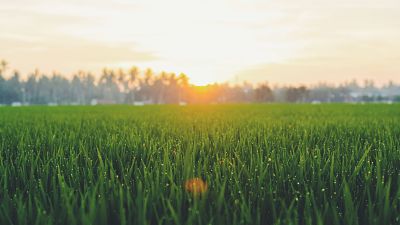
Many homeowners make the mistake of leaving their lawns unattended during late fall or ignore to properly prepare them for winter. This hinders the grass’ ability to absorb enough moisture, water, and nutrients it needs to survive the long, dormant winter.
Late fall is the perfect time to prepare and perform common maintenance practices on your lawn and landscape. If done correctly, you can be sure your lawn would not only live through the winter weather but thrive the following spring.
Are you unsure where to start? Don’t worry; we have some tips which should help you prepare your grass for a lush field of grass come spring.
Table of Contents [show]
How Can Improper Preparation Hurt Your Lawn Next Year?
When the cold weather sets in, we are always at risk of a myriad of health conditions. But we always take the necessary precautions to protect ourselves and outlive the brutal winter season.
It’s not only humans who are affected by the freezing temperatures, lawns too. Winter weather can have a significant impact on your lawn in many ways, and what you do to prepare it for the cold weather can help it survive or kill it.
Below are some of the types of damages that cold weather can cause on your lawn.
Winterkill
Winterkill is a term that describes a combination of diseases that affect turfgrass lawns health during winter months. These diseases usually prevent grass from becoming green again in the spring.
These are the factors that contribute to winterkill:
Low-temperature injury: Occurs when new lawns – installed right before the winter and haven’t had sufficient time to establish – are exposed to snow, ice, and freezing rain. Since the soil moisture is already high, the accumulation of ice crystals on the grass for an extended period causes more damage and even kills warmer season grasses. They can also cause root damage.
Winter Dehydration: Also known as direct low-temperature kill, this injury occurs during the first freezing days of winter following the relatively warm period in late fall.
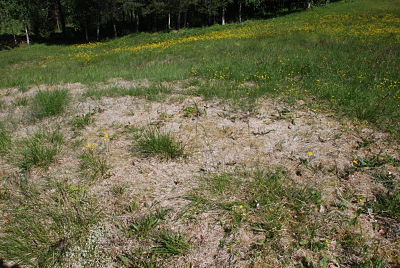
By Bevegelsesmengde – Own work, CC BY-SA 3.0, https://commons.wikimedia.org/w/index.php?curid=10712563
Snow Mold: Grey or pink snow mold are fungus diseases that develop under snow cover. These are usually found when the snow begins to melt away from the grass. You can know your turf is infected with snow mold when it has bleached and mattered together. As fungal growth continues, infected areas usually start showing patches. This unhealthy ailment can make your grass look sick and bald in places once the spring thaw comes.
Winterkill can happen to any lawn. However, the degree of damage depends on whether your lawn was properly prepared or not. The best way to prevent Winterkill is to identify areas in your lawn that are more susceptible to these diseases. Monitor and manage such areas by watering them during extended dry fall and winter periods. When you intend to water the grass, make sure the air and soil temperatures are above 40 degrees with no snow present.
Desiccation/ Winterburn
Desiccation refers to water loss as a result of the frigid weather. This problem is usually linked to dry or frozen soil. Consequently, there may be insufficient moisture reaching the roots of the grass and plants. Not all plants can survive Winterburn, so be sure to watch for symptoms such as marginal leaf scorch, tip burn, leaf mottling, leaf drop, or death of entire leaves, twigs, or plants.
Damage and Death
Large amounts of snow can damage the health of your lawn. While you can help your turfgrass by cleaning up after a heavy snowfall, give the frozen snow time to melt. You shouldn’t step on your lawn when it has snow because your weight and pressure from the snow can damage the grass, especially if it was weak before the winter season.
When Should I Have Everything In My Yard Ready For Winter?
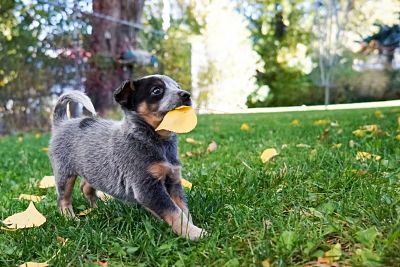
Autumn or late fall is the perfect time to prepare your lawn for the harsh winter. To be specific, September is when you should start laying the groundwork, and your lawn should be ready by the end of November or start of December. All you need to do at this time is to aerate the turf to reduce compaction and make it easier for fertilizer and water to reach the roots. You should also reinvigorate thin areas with compost and seed.
Just remember: the proper approach to maintaining a gorgeous lawn depends on where you live. What is good for a California lawn wouldn’t make sense for a lawn in Georgia. So, a little research and a climate-appropriate approach will help you keep your lawn healthy.
Before you start your lawn prep, it is crucial that you get the soil tested so that you know the type and amount of amendments to add.
What are the biggest things NOT TO DO For Winterizing My Lawn?
If you’re ready to give your lawn the attention it requires during fall, watch out for mistakes.
While it’s recommended that you hire a lawn care professional, many homeowners still prefer the do-it-yourself lawn care. So, if you’re like most people, you must strictly follow the instructions provided by your local lawn care specialist, otherwise, your pursuit of bringing your lawn to life will be fruitless.
Here are the five most common mistakes you should be aware of and try to avoid making when preparing your lawn for winter.
Scalping The Lawn
It is a common occurrence for people to allow their grass to grow too tall. And when they decide to mow, they cut it too short. Trimming your lawn too often or too short is damaging and can leave the grass stressed out. More importantly, it will limit its ability to absorb sunlight, and in consequence, affecting the growth of young grasses.
Keep in mind that you shouldn’t allow your lawn to grow too tall, either, or you’ll be inviting weeds that would kill shorter grass.
The ideal mower height should be about 2-1/2 inches, and you should never cut off more than 1/3 of the grass blade at any one time.
Watering Too Frequently
Fall is not the time to water your lawn daily. The weather is relatively cooler, which means your lawn doesn’t require frequent watering.
Therefore, you should run your sprinkler less often and within a short time. If you are in a cooler climate, it won’t harm to stop your sprinklers altogether. You’ll avoid freezing in your lawn as well as save water.
Improper Use of Fertilizer
Regular and proper fertilization can help your lawn grow thick and full, which in turn helps them fight weeds that try to take up the roots.
However, don’t fall into the habit of over-fertilizing your weed. You’ll not only be wasting that expensive fertilizer but also causing the growth of excess leaves and limiting root growth.
Bagging Lawn Clippings
Instead of collecting cut grass, you can use a self-mulching mower to help return grass clippings to the soil.
The whole purpose of mulching is to provide the turfgrass with nutrients which are released when the clippings are broken down.
One of the essential nutrients that are released is nitrogen. A slow and continuous release of nitrogen improves your lawn’s health and reduces the need for fertilization by as much as 25%. Moreover, mulching keeps grass clippings out of landfills.
Preparing Your Yard For A Great Next Year:
Should I put down more seed? If so, why?
The secret to a healthy and greener lawn is not only to select the right type of turf grass, but also plant a variety of seeds. When you plant more than one seed, your lawn is more likely to weather poor conditions, like heat and drought.
It’s worth understanding that different types of grasses perform better in some areas than others. Depending on your zone, you need to find out if you’ll need warm-season or cool-season grasses. The transitional zone usually presents extreme challenges to turf grasses.
If you’re not sure how to go about selecting the right seeds for your lawn, you can start with 50% Blue Grass and 50% fescue. The blue grass is a dense, colorful cool-season grass that will make your lawn looking green and attractive. On the other hand, the fescue will offer your lawn the density and tensile strength it deserves to survive the harsh heat and drought.
Should I Aerate? And if so, when? And how?

The only way to allow air, water, and nutrients to penetrate the growing grass or lawn thatch is through aeration. This involves making small channels which help loosen compacted soil.
You should strive to aerate your lawn in late spring or early autumn. This is usually the growing season when the grass can heal faster and remove plugs of soil from the lawn. Since you’re preparing for winter, aerate your lawn with cool season grass.
So, how do you aerate a lawn?
First, make sure the soil is moist. Ideally, you should aerate a day after watering or a rain shower. Most aeration machines don’t allow you to cover a large percentage of soil surface per pass, so you’ll have to make multiple passes over the most compact areas. Plus, save your energy and resources by attending to only affected areas.
Allow the excavated soil plugs to dry and break up to give your lawn a uniform, clean appearance. Still, you can run them over with a lawnmower or pound them with the back of your rake.
It’s also good to note that aerating your lawn in the fall even when you had applied a pre-emergent herbicide in the spring will not destroy the herbicide “barrier.” So, you don’t have to worry about crabgrass control or weed prevention. Remember to follow aeration with basic lawn care practices such as proper fertilizing, mowing and watering.
Do I fertilize? And if so, what type should I use?
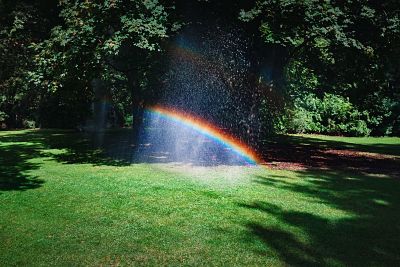
As we have discussed earlier, you need to fertilize your lawn in the fall, but with caution. This is particularly important if you missed fertilizing in spring.
Taking the time to fertilize in the fall can helps your lawn in many ways. It can strengthen the roots, giving your plants and lawns the stamina to live through winter and thrive next spring. Moreover, the fall morning dew delivers moisture that helps turf absorb the fertilizer.
The best time in fall to apply fertilizer to your lawn is 2 to 3 weeks before the ground freezes. You can know when the ground freezes in your area by finding out the first frost date in your area. By preference, that date should be the perfect time to fertilize because the ground hasn’t frozen yet. To be specific, this date should be around mid-October.
It’s vital that you apply the right type of fertilizer. Since the grass is still growing, you need to use fertilizers that contain slow-release nitrogen. These will release small and steady amounts of nutrients over the course of time throughout the spring. The result is a healthier and thicker turfgrass.
Refrain from applying too much fertilizer as it would only cause excess leaf growth and limit root growth. More importantly, an excess of fertilizer can also burn the lawn.
What about watering?
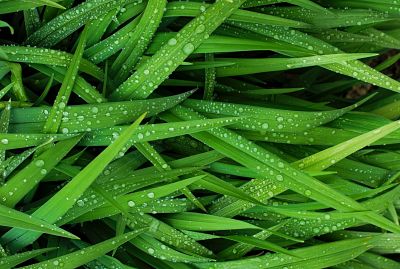
At this particular time of year, your lawn needs to absorb all the moisture it can get to prepare for the harsh winter. However, that shouldn’t be a reason to water your lawn every day.
Over-watering effects the strength of grass root systems. When the grass develops a weak deep root system, it’s unable to transfer enough water deeper in the soil. As a result, they become vulnerable and dependent on supplemental water during drought. Even more, the grass can become soggy, which means they’ll be more likely to develop fungus and contract diseases.
Excessive over-watering also increases the growth rate of your grass, which forces you to cut it too often, and sometimes too short, leading to problems we have discussed earlier.
Furthermore, when you water your lawn too often, you wash away your expensive fertilizer. So, you’ll be wasting money and damaging the precious groundwater.
For better results, maintain a deep and infrequent watering throughout the year. And don’t water more than one inch per week. You should strive for a third of an inch of water three times a week.
Besides, you can invest in a soil moisture meter. These are handy and inexpensive tools that you should find in your local garden center.
What is best to do with leaves falling? Mulch/rake or let them sit?
When those colorful leaves start tumbling from treetops littering your lawn, you know it’s time to act. Having a few leaves on your lawn doesn’t cause any harm. But you need to remove them when they start piling up.
Unless you want to have to do a lot of lawn repair next year, don’t ignore that layer of leaves on your lawn. At the very least, they block sunlight from reaching the grass blades and limit air circulation.
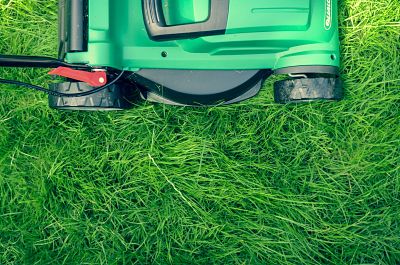
Also, if you let them stay for too long, they can cause turf diseases and prevent the grass from growing properly. Even worse is the risk of root rot which would eventually kill your grass completely.
You can take the necessary action against leaves if they cover more than a third of your lawn or when you can’t see the top half of the grass blades. Fall is relatively cold which triggers leaves to drop quickly (obviously).
Typically, you can wait for a few days until the lawn is fairly covered with a single leaf layer before needing to take action. However, if you have a heavy leaf fall, don’t wait several days before taking care of your lawn.
Whatever plan you have for the leaves, make sure you do it before rain arrives. Wet leaves are not easy to chop with the mower, and they almost always clog rakes and leaf vacuums.
Generally, you should skip raking completely and mow the leaves into small pieces. You may need to mow over them several times to achieve the smallest sizes, especially if they are too large or if the layer is too thick.
You can stop mowing when you can see approximately 50 percent of the grass through the leaf pieces. It always better if you can see more greens than leaves as it would speed up decomposition. Applying a fall-timed fertilizer would provide the much-needed nitrogen that breaks down the leaves faster.
Proper Tips On Mowing and Trimming Your Yard To Prepare For Cold Weather
When should I mow?
As winter approaches, you’ll realize that grass growth slows down. While many people would probably stop mowing, it’s wise to continue mowing each week like you normally would (and trimming obviously). Remember, leaves are still falling as well, so you need your lawn to decompose all those leaves, especially if want to avoid raking.
How long should the grass be for winter?
Many people tend to mow the grass too short with the intention of saving energy or time. This is a mistake and an ill-conceived way of saving time. If you mow too short, you’ll damage the grass, hindering the roots from absorbing all the essential nutrients. Like mentioned before, trim your lawn to 2 ½ to 3 inches and don’t cut off more than 1/3 of the height of the grass in any one mowing. Also, sharpen your blades and mow when your lawn is dry.
How To Prepare Flower Beds And Gardens For Winter
How should you handle plants or flowers?
In warm winter areas, autumn is the right time to prepare and plant a flower bed. A lot of things happen during this time – plants and flowers grow at a much slower pace, and the conditions are right for rotting to occur. So, start off by checking for signs of diseases.
While the temperature is getting lower by the day, it’s still advisable to water your perennials frequently. You can stop when the soil is entirely frozen and can no longer accept water. This will help maintain a strong root system, increasing the chances of the flowers re-sprouting next year.
Do you trim or completely remove?
After the first frost, plants begin to decline and head toward winter dormancy. This is a good time to cut back the foliage to the ground. Continue doing the same for days or weeks until you’re sure all perennials have gone into dormancy. Watch for semi-evergreen perennials; you don’t have to cut them until winter has passed.
Besides, you can choose not to cut until spring if necessary. And leaving some plants in the garden will provide winter interest, act as snow collectors as well as provide food for the birds. If you choose not to cut your plants, make sure you set aside some time in the spring to do the cleanup.
Finally, when the ground is already frozen, replace old mulch with two to three-inch layer of hay, evergreen boughs, or floating row covers. Doing this will protect tender perennials and insulate the bed. To limit excess water accumulation and rot to the plants, don’t pile mulch around their bases or cover them.
Do I use weed killer?
You need to remove weeds from your flower beds before winter. While these plants won’t grow just like flowers during winter, killing them would eliminate competition. Moreover, it’s a good way to destroy any hiding places for insects and other pests that might be trying their luck this winter.
You can target both annual and perennial weeds at the same time. Which is why you’ll require a weed killer that combines a pre- and post-emergent herbicide. Post-emergent herbicides will take out weeds that have already grown while pre-emergent herbicides will kill weeds that haven’t sprouted yet.
How To Help Prevent Mosquitoes Next Year By Winterizing Your Yard
Just because it’s winter doesn’t mean you should forget about controlling mosquitoes. These buzzing little pests are vigilant, and if you don’t take the necessary precautions early on, then you’ll likely have to work twice as hard to get rid of them.
- Start by draining areas around your home with standing water. Mosquitoes spend their fall preparing for winter, and you don’t want to be one to help them. So, to avoid getting bit in the warmer months, clear all the mosquito breeding grounds.
- If you have any water ground around your home that can’t be drained, add BTI (bacillus thuringiensis israelensis). These are a group of bacteria that can be used to control mosquitoes and other insects.
- Grow mosquito repellent plant around your home. These plants release strong fragrances that keep mosquitoes away. Good examples are lavender or marigolds.
- Clean your gutters to remove clogging debris. Consider installing gutter covers so you don’t have to clean them regularly.
Can composting help your yard?
Many homeowners prefer to compost 2-3 times a year because it’s a sure way to add organic fertilizer to yards or gardens. Compost not only makes a great fertilizer consisting of essential nutrients like nitrogen, phosphorus, and potassium, it also has traces of elements that you don’t ordinarily find in chemical-based fertilizers.
Other benefits of compost include:
- It works quickly
- Unlike commercial fertilizer, compost doesn’t burn your grass out if you accidentally put too much on.
- Doesn’t stain your concrete or brick walkways.
- Doesn’t smell even if you use old manure-based fertilizers.
Our Last Words
There is no better time to prepare your lawn for winter than autumn.
As the soil continues to maintain its summer warmth coupled with the more frequent rainfall, your lawn is busy absorbing energy, moisture, and essential moisture it need to survive the harsh winter.
Give your lawn all the attention it deserves, and it will repay back in the spring.

